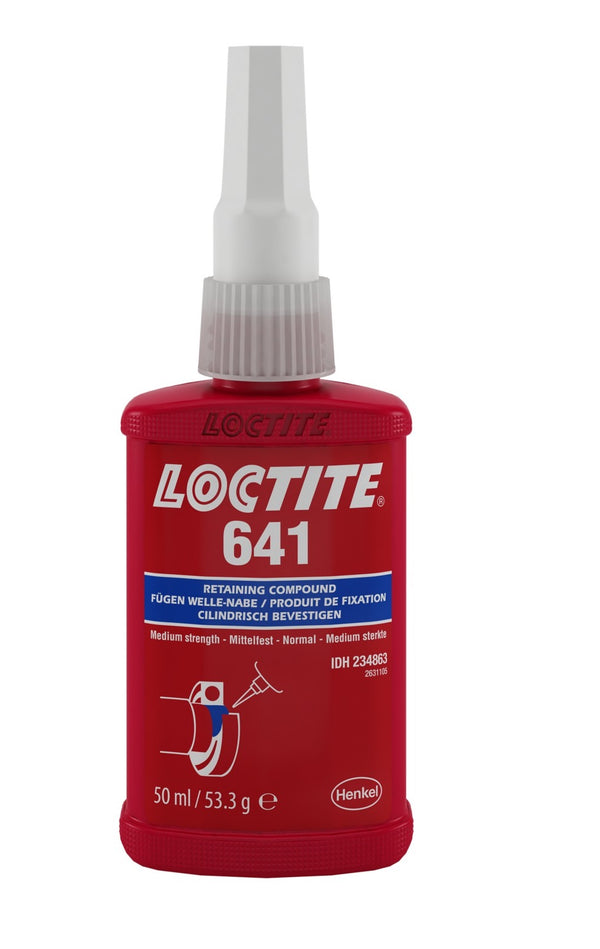
LOCTITE® 641
Anaerobic retaining agent - moderately dismountable adhesive for gluing coaxial parts including bearings on the shaft that prevents them from turning
LOCTITE® 641 is designed to bond coaxial parts and is particularly recommended for applications where subsequent disassembly for inspection is required. The product cures in the absence of air when placed between close-fitting metal surfaces and prevents loosening of joints and leakage caused by shock loads and vibration.
Effective for gaps not larger than 0.15mm
Applications Application
Perfect for parts that will be dismantled in the future, e.g.
- bonding of bearings mounted on shafts and in seats
- other coaxial connections
Features and Benefits
- effective protection against loosening of parts exposed to vibrations
- It is perfect for parts that are planned to be dismantled periodically.
- one-component - does not require mixing
Typical properties
| Technology | acrylic |
| Compound | Dimethacrylate ester |
| Color Form | Yellow liquid |
| Fluorescence | LACK |
| Ingredients | One-component |
| Viscosity | Mean 600.0 mPa.s (cP) |
| Hardening | Anaerobic product |
| Hardening - option | Activator |
| Application | Coaxial fixing |
| Resilience | Mean |
| Relative density @ 23°C | 1.07 |
| Viscosity, Brookfield - RVT, 25 °C, mPa s (cP): Spindle 2, speed 6 rpm / minute Spindle 2, speed 20 rpm. |
1215 to 2750 400-800 |
| Viscosity, EN 12092 - MV, 25 °C, after 180 s, mPa s (cP): Shear rate 277 s-1 |
90 to 180 |
| Settling time | 20 minutes |
| Operating temperature | -55.0 - 150.0 °C |
| Shear strength, Steel | 12.0N/mm² (1700.0psi) |
| Average curing time at 22 °C. | 24 hours |
Typical Curing Course
Curing speed depends on the material
The curing speed depends on the material used. The graph below shows the shear strength developed over time on steel pins and sleeves w
compared to other materials, tested according to ISO 10123

Curing speed depending on the gap
Cure rate is dependent on gap size Chart below shows shear strength developed over time on steel pins and sleeves
at various controlled gaps; tests according to ISO 10123

Cure speed depending on temperature
The curing speed depends on the ambient temperature. The graph below shows the shear strength developed over time at different temperatures
steel shafts and sleeves tested according to ISO 10123

Curing speed depending on the activator

Temperature strength
Durability tests depending on the temperature are presented in the chart below

GENERAL INFORMATION
This product is not recommended for use with pure oxygen and/or oxygen rich equipment; nor should it be used for installations with chlorine and other materials
strongly oxidizing.
Installation
- For best bonding results, clean all surfaces (exterior and interior) with LOCTITE® remover and let them dry
dry - If material is passive or curing speed is too slow, spray Activator 7471 or 7649 onto surfaces and allow to dry
- For slip fits, apply the product to the lead-in chamfer on the shaft and inside the sleeve and twist the parts together
- For press-fit joints, apply the adhesive carefully to both surfaces and press-fit quickly
- For shrink joints, apply the product to the shaft, heat the sleeve to obtain the possibility of free connection
- Joint parts should not be fully loaded until full strength is achieved
Disassembly
- Heat locally to approx. 200 °C. Hot disassemble
Cleaning
- Cured product can be removed with LOCTITE® solvent
or using mechanical treatment, e.g. with a wire brush
Storage
Unless otherwise indicated on the product label, the ideal way to store it is to leave it in closed containers in a cool and dry place. Optimum storage temperature: 8 °C to 21 °C.
Storage at temperatures below 8 °C or above 28 °C may irreversibly change the properties of the product.
Product title
Vendor
19,99 zl PLN | 24,99 zl PLN
Product title
Vendor
19,99 zl PLN | 24,99 zl PLN
Product title
Vendor
19,99 zl PLN | 24,99 zl PLN
Product title
Vendor






























